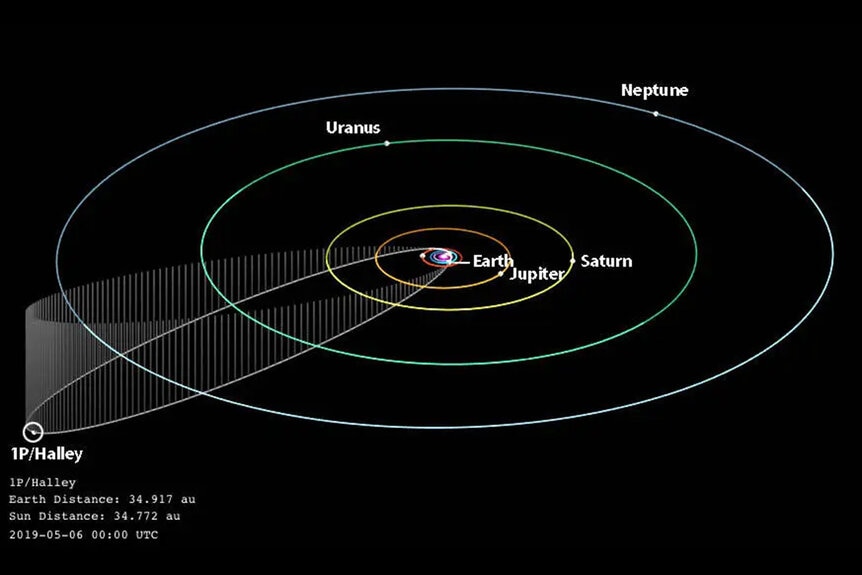Create a free profile to get unlimited access to exclusive videos, sweepstakes, and more!
Halley’s Comet Is Headed Back Our Way
The return trip begins this weekend.

In Wes Anderson’s latest stylized cinematic tale, the titular Asteroid City (streaming now on Peacock) crops up around an impact crater in the desert. The real adventure kicks off when an honest-to-Crom space alien shows up, takes the meteorite back into deep space, and later returns it.
On screen or in the real world, the temporary disappearance and reappearance of a cosmic object is almost always cause for excitement. And few celestial visitors are as well-known or as celebrated as Halley’s Comet. For many, seeing Halley’s Comet is literally a once in a lifetime opportunity; it only shows up every 76 years, and the path toward its next visit begins this weekend.
Halley’s Comet Is Turning Toward Earth This Weekend
On Saturday December 9, the comet will reach aphelion, the point along its orbit which is farthest from the Sun. See, Halley’s orbit is pretty weird when compared to the Earth’s. Orbits are almost always a little squashed, meaning they get a little closer and a little farther from their parent body at different points. You’ve probably heard that the Earth orbits 93 million miles from the Sun, but that’s just an average. At the Earth’s closest point, it’s about 91.4 million miles from the Sun; at its farthest it’s about 94.5 million miles. There’s a swing of a few million miles throughout the year, but it’s hardly noticeable.
RELATED: The Remains of Halley’s Comet Burn and Linger in the Sky
If the Earth’s orbit is pretty close to the circular part of the orbital spectrum, then Halley’s orbit is way over on the other side. At nearest approach Halley gets to within about 55 million miles, closer than Venus. Then it whips way out to 3.2 billion miles away, midway between Neptune and Pluto. Right now, Halley is racing away from us, its speed slowly declining as the Sun’s gravitational bungee cord is pulled taut. Once it reaches aphelion, Halley will bend back toward us on a decades-long return journey.
Halley’s Comet was named for astronomer Edmond Halley, who is credited with figuring out that it was a period comet which would return to our skies at regular intervals. In 1696, Halley predicted that the comet would return in 1758. He didn’t live to see his prediction validated, but his name became synonymous with the comet he studied. The object itself is only about 11 kilometers (6.8 mile) across at its widest point, but it has an outsized impact on our relationship to the night sky.
RELATED: How The Wizard of Oz Inspired Asteroid City's Production Designer and Wes Anderson
In addition to being the most famous comet in the neighborhood, Halley is responsible for two annual meteor showers. The Eta Aquarids shower in May and the Orionids in October are both caused by scattered debris leftover from Halley’s previous passes. Every year we travel through its orbital path at those two points and Halley’s cometary bread trail lights up the night.
Saturday’s orbital event marks the halfway point between Halley’s last visit in 1986 and its next visit. Mark your calendars for July 2061. Maximum brightness is anticipated July 29, 2061, with an apparent magnitude of -0.3. That’s compared to a maximum brightness of 2.1 in 1986. Stellar magnitudes, like golf scores, are better the lower they are, meaning Halley’s next visit will be a good one. Halley should be about as bright as the stars Vega and Arcturus, visible to the naked eye.
In the meantime, keep your eyes to the skies with Asteroid City, streaming now on Peacock.



























